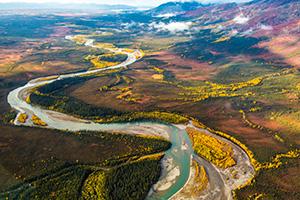Decreasing biodiversity affects productivity of remaining plants

Empirical evidence from Alaska's boreal forest suggests that every 1 percent reduction in overall plant diversity could render an average of .23 percent decline in individual tree productivity. Credit: Todd Paris/UAF
“The loss of biodiversity is threatening ecosystem productivity and services worldwide, spurring efforts to quantify its effects on the functioning of natural ecosystems,” said lead author Jingjing Liang, a forest ecologist from West Virginia University.
Ecosystem services include any positive benefit that plants and animals provide to people including food, fresh water, raw materials and medicinal resources.
A team of scientists, led by Liang, and using data from Alaska's boreal forests developed a model that measures and quantifies the effects of plant productivity resulting from a loss of species diversity.
Previous research focused the positive role biodiversity plays on resource acquisition by plants.
“What also differs our study from previous research is that we developed a theoretical model to quantify the influence of biodiversity on plant productivity at individual plant and community levels,” said A. David McGuire, an ecosystem modeler with the U.S. Geological Survey and University of Alaska Fairbanks' Institute of Arctic Biology. “This model enables the scientific community to better integrate biological conservation in natural resource management.”
While the world struggles to reduce the loss of biodiversity, concern is mounting over the ongoing relationship between biological conservation and poverty, especially in rural areas where livelihoods depend heavily on ecosystem resources, say the authors.
“The development of our ecological model was inspired and aided by an existing economic theory,” Liang said.
According to co-author and WVU economist Mo Zhou, the theory of diminishing marginal productivity in the context of ecology, indicates that marginal resource productivity will at some point decrease as resource acquisition increases.
“We demonstrate that conserving the diversity of plant species may help to maintain ecosystem services for current and future generations,” say Liang and Zhou.
###
Jingjing Liang, West Virginia University, School of Natural Resources, Jingjing.Liang@mail.wvu.edu
Mo Zhou, West Virginia University, School of Natural Resources, Mo.Zhou@mail.wvu.edu
Patrick Tobin, University of Washington, School of Environmental and Forest Sciences, pctobin@uw.edu
A. David McGuire, University of Alaska Fairbanks, Institute of Arctic Biology; U.S. Geological Survey, Alaska Cooperative Fish and Wildlife Research Unit, admcguire@alaska.edu
Peter B. Reich, University of Minnesota, Department of Forest Resources; University of Western Sydney, Hawkesbury Institute for the Environment.
Media Contact
All latest news from the category: Life Sciences and Chemistry
Articles and reports from the Life Sciences and chemistry area deal with applied and basic research into modern biology, chemistry and human medicine.
Valuable information can be found on a range of life sciences fields including bacteriology, biochemistry, bionics, bioinformatics, biophysics, biotechnology, genetics, geobotany, human biology, marine biology, microbiology, molecular biology, cellular biology, zoology, bioinorganic chemistry, microchemistry and environmental chemistry.
Newest articles

Sea slugs inspire highly stretchable biomedical sensor
USC Viterbi School of Engineering researcher Hangbo Zhao presents findings on highly stretchable and customizable microneedles for application in fields including neuroscience, tissue engineering, and wearable bioelectronics. The revolution in…

Twisting and binding matter waves with photons in a cavity
Precisely measuring the energy states of individual atoms has been a historical challenge for physicists due to atomic recoil. When an atom interacts with a photon, the atom “recoils” in…

Nanotubes, nanoparticles, and antibodies detect tiny amounts of fentanyl
New sensor is six orders of magnitude more sensitive than the next best thing. A research team at Pitt led by Alexander Star, a chemistry professor in the Kenneth P. Dietrich…





















